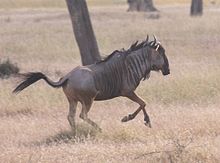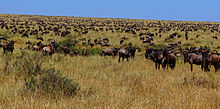
Wildebeest
About this schools Wikipedia selection
This Wikipedia selection is available offline from SOS Children for distribution in the developing world. See http://www.soschildren.org/sponsor-a-child to find out about child sponsorship.
| Wildebeest | |
|---|---|
 |
|
| Blue wildebeest, Ngorongoro Crater, Tanzania | |
| Scientific classification | |
| Kingdom: | Animalia |
| Phylum: | Chordata |
| Subphylum: | Vertebrata |
| Class: | Mammalia |
| Order: | Artiodactyla |
| Family: | Bovidae |
| Subfamily: | Alcelaphinae |
| Genus: | Connochaetes Lichtenstein, 1812 |
| Species | |
|
Connochaetes gnou – black wildebeest |
|
The wildebeest (pron.: / ˈ w ɪ l d ə ˌ b iː s t / WIL-də-BEEST or / ˈ v ɪ l - / VIL- , plural wildebeest or wildebeests, wildebeesties (juv)), also called the gnu (pron.: / ˈ n uː / NOO or / ˈ nj uː / NEW ) is an antelope of the genus Connochaetes. It is a hooved ( ungulate) mammal. Wildebeest is Dutch for "wild beast" or "wild cattle" in Afrikaans (beest = cattle), while Connochaetes derives from the Greek words κόννος, kónnos, " beard", and χαίτη, khaítē, "flowing hair", " mane". The name "gnu" originates from the Khoikhoi name for these animals, gnou.
Gnus belong to the family Bovidae, which includes antelopes, cattle, goats, and other even-toed horned ungulates. Connochaetes includes two species, both native to Africa: the black wildebeest, or white-tailed gnu (C. gnou), and the blue wildebeest, or brindled gnu (C. taurinus). Fossil records suggest these two species diverged about one million years ago, resulting in northern and southern species. The blue wildebeest changed very little from the ancestor species, while the black wildebeest took on more morphological changes to adapt to a habitat of open grassland in the south. Today, the blue wildebeest has five subspecies, while the black wildebeest has no named subspecies. In East Africa, the wildebeest is the most abundant big-game species, both in population and biomass.
Physiology
A full-grown wildebeest can be 1.27–1.47 m (4.2–4.8 ft) at the shoulder and weigh 120–270 kg (260–600 lb). They inhabit the plains and open woodlands of Africa, especially the Serengeti National Park, a UNESCO World Heritage Site in Tanzania, Masai Mara Game Reserve in Kenya, and Liuwa Plain National Park in Zambia. Wildebeest can live more than 40 years, though their average lifespan is around 20 years. The wildebeest has a broad muzzle shaped like a lawnmower, which helps it with eating short grass.
Differences between blue and black wildebeest
The most striking morphological differences between the black and blue wildebeests are the orientation and curvature of their horns and the color of their coats. The blue wildebeest is the bigger of the two species. In males, blue wildebeest stand 150 cm tall at the shoulder and weigh around 250 kg, while the black wildebeest stands 111 to 120 cm tall and weighs about 180 kg. In females, blue wildebeest have a shoulder height of 135 cm and weigh 180 kg while black wildebeest females stand 108 cm at the shoulder and weigh 155 kg. The horns of blue wildebeest protrude to the side then curve downwards before curving up back towards the skull, while the horns of the black wildebeest curve forward then downward before curving at the upwards at the tips. Blue wildebeest tend to be a dark grey color with stripes, but may have a shiny blue color. The black wildebeest has brown-coloured fur, with a mane that ranges in colour from cream to black, and a cream-coloured tail end. The blue wildebeest lives in a wide variety of habitats, including woodlands and grasslands, while the black wildebeest tends to reside exclusively in open grassland areas. The blue wildebeest migrates over long distances in the winter, whereas the black wildebeest does not. The milk of the female black wildebeest contains higher protein, lower fat, and lower lactose content than the milk of female blue wildebeests.
Migration

Wildebeest are famous for their annual long-distance migration, seemingly timed to coincide with the annual pattern of rainfall and grass growth. The timing of their migrations in both the rainy and dry seasons can vary considerably (by months) from year to year. At the end of the rainy season (May or June in East Africa), wildebeest migrate to dry-season areas in response to a lack of surface (drinking) water. When the rainy season begins again (months later), animals quickly move back to their wet-season ranges. Factors suspected to affect migration include food abundance, surface water availability, predators and phosphorus content in grasses. Phosphorus is a crucial element for all life forms, particularly for lactating female bovids. As a result during the rainy season, wildebeest select grazing areas that contain particularly high phosphorus levels. One study found, in addition to phosphorus, wildebeest select ranges containing grass with relatively high nitrogen content. Large-scale wildebeest migration is quite likely a consequence of decisions being made by individuals at multiple spatial scales, involving a balance of food abundance, food quality, local density of other wildebeest, social interactions, surface water, perceived predation risk, and culturally (or possibly genetically) learned routes and ranges.
Numerous documentaries feature wildebeest crossing rivers, with many being eaten by crocodiles or drowning in the attempt. While having the appearance of a frenzy, recent research has shown a herd of wildebeest possesses what is known as a " swarm intelligence", whereby the animals systematically explore and overcome the obstacle as one. Major predators that feed on wildebeest include the lion, hyena, cheetah, leopard, and crocodile, which seem to favour the wildebeest. Wildebeest, however, are very strong, and can inflict considerable injury even to a lion. Wildebeest have a maximum running speed of around 80 km/h (50 mph). The primary defensive tactic is herding, where the young animals are protected by the older, larger ones, while the herd runs as a group. Typically, the predators attempt to cut out a young or ill animal and attack without having to worry about the herd. Wildebeest have developed additional sophisticated cooperative behaviours, such as animals taking turns sleeping while others stand guard against a night attack by invading predators. Scientists are unsure how much is learned behaviour and how much is instinct. Wildebeest migrations are closely followed by vultures, as wildebeest carcasses are an important source of food for these scavengers. The vultures consume about 70% of the wildebeest carcasses available. Decreases in the number of migrating wildebeest have also had a negative effect on the vultures. In the Serengeti ecosystem, Tanzania, wildebeest may help facilitate the migration of other, smaller-bodied grazers, such as Thomson's gazelles (Eudorcas thomsonii), which eat the new-growth grasses stimulated by wildebeest foraging.
Interactions with nonpredators
Zebras and wildebeest group together in open savannah environments with high chances of predation. This grouping strategy reduces predation risk because larger groups decrease each individual’s chance of being hunted, and predators are more easily seen in open areas.
Wildebeest can also listen in on the alarm calls of other species, and by doing so can reduce their risk of predation. One study showed, along with other ungulates, wildebeests responded more strongly to the baboon alarm calls compared to the baboon contest calls, though both types of calls had similar patterns, amplitudes, and durations. The alarm calls were a response of the baboons to lions, and the contest calls were recorded when there was a dispute between two males.
Breeding and reproduction
Due to their migratory ways, the wildebeest do not form permanent pair bonds. The wildebeest mating season, rut, is when the males establish temporary territories and try to attract females. These small territories are about 3000 square meters, with up to 300 territories in a square kilometer. The males defend these small territories from other males while trying to attract females that are ready to mate. The males entice females into their territories with grunts and distinctive antics. Wildebeest usually breed at the end of the rainy season when the animals are most fit. The mating season usually occurs between May and July, and birthing usually takes place between January and March, at the start of the wet season. The gestation period is about eight to 9 months, and the average estrous cycle is about 23 days. Wildebeest females breed seasonally and ovulate spontaneously. Groups of wildebeest females and young live in the small areas established by the male. When groups of wildebeest join together, the female to male ratio is larger, as the females flock to the areas held by fewer males. This female-dominated sex ratio may be due to illegal hunting and human disturbance. Higher male mortality has been attributed to illegal hunting.
Hybrids
Due to their confinement in small areas in South Africa, the two species of wildebeest, the black and the blue wildebeest, have interbred, resulting in fertile hybrid young. These two species are brought into close contact with each other on game farms and reserves in South Africa. The resulting hybrid young may include characteristics of both species and even some intermediate traits. The hybrids also tended to have strange dental, horn, and skull shapes.
Conservation and management
Wildebeest still number in the thousands, or even hundreds of thousands, in numerous areas in eastern and southern Africa, which is a testament to the local efforts and foresight to conserve and manage these animals. However, many wildebeest populations are experiencing rapid declines. Overland migration as a biological process requires large connected landscapes, which is increasingly difficult to maintain, particularly over the long term, when human demands on the landscape compete, as well. The most acute threat comes from migration barriers, such as fences and roads. In one of the more striking examples of the consequences of fence-building on terrestrial migrations, Botswanan authorities placed thousands of kilometres of fences across the Kalahari that prevented wildebeests from reaching watering holes and grazing grounds, resulting in the deaths of tens of thousands of individuals, and dropping the wildebeest population to less than 10% of its previous size. Wildebeest migrations in the Serengeti and Tarangire ecosystems, Tanzania, are also threatened by the construction of a roadway across their northern portions. The impact of this road on migratory wildlife will undoubtedly be negative and reduce the aesthetic value of the ecosystems, but the magnitude of the impact (in numerical terms) on the population will depend on the extent to which the road acts as a barrier to movement, causes collision mortalities, and opens the area to illegal hunting. In addition to roads and fences, illegal hunting is a major conservation concern in many areas. In the western Serengeti, scientists estimate tens of thousands of animals are poached each year, largely using wire snares. Other ecosystems are experiencing similar pressures, such as the Tarangire ecosystem in Tanzania, which historically supported large numbers of migratory wildebeest (as well as other species), but has recently declined in number, coincident with illegal hunting and land-use changes across the rainy season ranges. An important question in populations threatened by barriers and other pressures is whether and how they adjust to a less migratory lifestyle. Although the majority of wildebeest populations migrate, some populations do not, and appear to never have done so in recorded history. Such populations can be found in the Ngorongoro Crater, the Masai Mara, Lake Manyara National Park, Selous Game Reserve, and Hwange and Esotha National Parks.
Legal harvesting
Wildebeest are killed for food, especially for biltong in Southern Africa. This dried game meat is a delicacy and an important food item in Africa. The meat of females is more tender than that of males, and is the most tender during the autumn season. Wildebeest are a regular target for illegal meat hunters because their numbers make them easy to find. When preparing the wildebeest carcass, it is usually cut into 11 pieces. The estimated price for wildebeest meat is about US$ 0.47 per kilogram.



